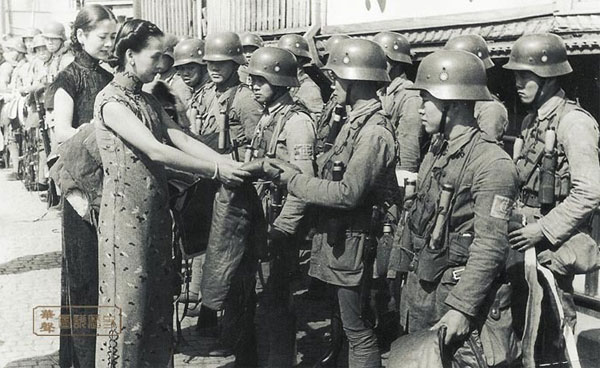The Granddaddy of Blitzkrieg
 |
| Bird's eye view of a Blitzkrieg |
Blitzkrieg ("Lightning War") was the doctrine that secured Nazi
Germany's stunning and totally lopsided victories early in WW2 against
opponents with a significant to huge numerical superiority, namely France and
the USSR. It was a sophisticated system that used modern technology across the
board, when many armies around the world still were more-or-less unchanged
since the time of Napoleon. Hard training, good weapons, reliable radios, and
most important, outstanding leadership by generals such as Guderian, Rommel,
and von Manstein made the German army irresistible. While these officers were
master practitioners of Blitzkrieg and among the most famous of the panzer
generals, they owed it all to a petite, trim, owlish-looking man named Hans von
Seeckt.
 |
| Up to no good: von Seeckt thinking about more mischief |
A gifted officer born in 1866, von Seeckt gained a well-earned reputation
for being instrumental in the handing of severe defeats to his opponents during
WW1. Seeing action on several fronts, von Seeckt was awarded the Pour le Merite
(the “Blue Max”) not once, but twice.
 |
| Overachiever: An example of a Blue Max with an Oak Leaf cluster like von Seeckt's |
His greatest military successes were
gained while serving under the flamboyant Field Marshal von Mackensen, and a
saying started going around: "Where Mackensen is, Seeckt is; where Seeckt
is, victory is." In addition to his hard-nosed military skills, von Seeckt
was essentially a Renaissance man in a military uniform; fluent in several
languages, he was also at home discussing topics such as art and literature.
 |
| Not subtle: Big Mackensen |
Of course, WW1 ended in defeat for Imperial Germany, and von Seeckt, like
many others, faced a very uncertain future. However, the leadership of the new
Weimar Republic knew that the Army was crucial to maintaining order in the instability
of post-war Germany, but who could they trust to lead it? The Center-Leftists in
power were despised by the officer class almost to a man, but one name kept
percolating up; Hans von Seeckt. It was felt that von Seeckt, being the
consummate professional soldier that he was, would both work with what he had
and also would not work against the state as it existed at that time. It proved
to be a fateful choice indeed, as von Seeckt proceeded to out-maneuver and/or
use them in any way he saw fit. They chose him for both the right and the wrong
reasons.
General von Seeckt, who was a representative at the Versailles Treaty
conference, knew what to expect, and immediately started to work on
“neutralizing the poison contained in the disarmament clauses of the Treaty.”
He turned the postwar German army (limited to 4,000 officers and 100,000 men
total) into an elite, virtually hand-picked force; only the best were retained.
The Treaty didn’t mention the number of Non-Commissioned Officers (NCO’s, or Corporals
and Sergeants to the layperson) the army could have, so von Seeckt saw to it
that as many NCOs as possible were officer material. General von Seeckt foresaw
the days when armies “would be relatively small, but of very high quality, and
made distinctly more effective by the use of aircraft”. He also stressed the
importance of divorcing military personnel from politics, his attitude being
the army serves the state and its people, and not necessarily its masters.
 | |
| From this... |
In addition to personnel, von Seeckt also concerned himself with hardware,
and saw to it that German weapon development went on unabated in other countries
like Holland, Sweden and elsewhere in addition to covert activity within
Germany itself. His most unusual dealings were with the other world outcast at
the time, the Soviet Union. General von Seeckt arranged for munitions to be
made there, and secret training centers were set up deep in Soviet territory,
the most prominent one being the fighter pilot school at Lipetsk, which is a
functional Russian air base to this day.
The munition scheme went on until the
mid-20’s, when, ironically, Communist longshoremen in Germany discovered
artillery shells among the cargo and alerted the press. The fighter school at
Lipetsk and other facilities lasted until 1933; when Hitler took power, the
Soviets abruptly closed the schools and expelled the German cadres.
 |
| From this... |
 |
| ...to this. |
Although
the Treaty forbade Germany from having artillery greater than 150mm in caliber,
it made no mention of rockets, so von Seeckt secretly funded rocket development
as a form of long-range artillery, which culminated in the V-2.
All of von Seeckt’s machinations came to an end in 1926, when he allowed a
member of the deposed Kaiser’s family to attend an army field exercise in full
uniform, which caused a political firestorm; von Seeckt, himself politically a
conservative monarchist, was forced to resign.
 |
| Unusual sight: von Seeckt in civilian attire |
After dabbling in politics for a
couple of years, von Seeckt yearned for a return to military life, which he did
by becoming a military advisor to Chiang-Kai-Shek of Nationalist China in the
early 1930’s.
 |
| They liked German helmets too: Nationalist Chinese soldiers |
True to form, von Seeckt engineered a series of actions against
the communists that defeated them and forced them into the Long March, which
had the effect of consolidating and concentrating Mao’s power, which eventually
resulted in the communist victory in 1949. General von Seeckt died in 1936. I
wonder if von Seeckt had a clue as to what his legacy would be, but he is
without a doubt behind some of the most fateful decisions and actions in world
history.
 |
| What the hell did you do? |




